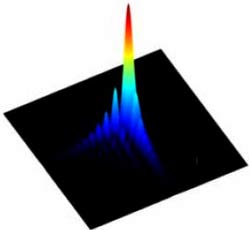Airy optical beam was first observed
Lisa Zyga
For the first time, scientists have observed unusual optical beams called Airy rays. Unlike other light rays, Airy rays have the ability to maintain diffraction in a far distance, and can accelerate freely during light transmission.
Scientists include: Georgios Siviloglou, John Broky, Aristide Dogariu, and Demetrios Christodoulides from CREOL University - Florida Central University (UCF) hope that the unusual features of Airy beams will be applied in manipulation. elements and nonlinear media. The group's study, published in Physical Review Report, describes Airy beam observation from one-dimensional and two-dimensional shapes.
Airy's name comes from the ' airy integral ' introduced by George Biddell Airy in the 1930s to explain the phenomenon of rainbow caustics. Airy rays were first predicted in 1979 by scientists Michael Berry and Nandor Balazs in quantum mechanical range. They developed the theory of the existence of free particles, described by Schrödinger's equation, that can produce Airy beams that do not spread during transmission - saying otherwise that they are not diffracted. It is noteworthy that the Airy beam is capable of special free acceleration, even in the presence of external agents .

2D diagram of Airy rays.
(Photo: Georgios Siviloglou et al)
' We do not understand why the great prediction once brought Michael Berry's reputation to be forgotten, ' Christodoulides told PhysOrg.com. ' We think partly because it was first published in an unknown newspaper. The second problem involves conducting experiments. Just recently, we realized that exponentially cut Airy rays had a Gau-fiber energy spectrum, which could therefore be easily generated from the Gau-ray beam. '
The UCF researchers found the existence of two other two-dimensional non-diffraction beams such as the so-called Bessel beam produced by the conical stacking of planar rays. Due to the non-diffraction, Bessel beam characteristics of the theory of infinite energy. However, due to the lack of space and energy, Bessel beams are cut and diffracted during light transmission.
Unlike Bessel beams and other non-diffraction beams, Airy beams do not result from conical superposition. Furthermore, the researchers created Airy beams using a controlled space light device via a computer. This device synchronizes the Gau-ray beam, on a CCD camera that displays the image of the process. Scientists use many different synchronous masks to produce one-way or two-dimensional Airy rays.
They also observed that the Airy local intensity characteristics make it accelerate freely. This is because this type of beam is similar to the wave function of quantum mechanical elements observed in a free-fall state. Although the center volume of the center is constant, the local intensity runs in a parabolic curve in the range of 25-30 cm before undergoing diffraction. In contrast, a normal Gau-ray of the same size will span 24 times the same range.
"This ray of light is capable of accelerating freely or bending itself in the process of transmitting light without changing its shape ," Christodoulides explains. ' It is still known that light travels in a straight line, but in this case, Airy beams follow a parabolic curve similar to that of a cannon ball under the influence of gravitational force. '
The scientists explained that, thanks to the ability to separately regulate the x and y parameters of Airy rays, the acceleration of this non-diffraction beam can be controlled. They just change the technique a bit differently when one-dimensional Airy beams can produce the first non-dispersive Airy circuits in optical fibers. In addition, non-diffraction Airy beams are very useful in element manipulation and nonlinear media.
According to Mr. Christodoulides: 'This beam is not asymmetrical in intensity, its application is still being studied. Furthermore, the radiation zone that does not move in a straight line of Airy rays (containing more than 50% of its energy) can be used to disperse particles by radiation pressure. '
- The light was 'bent'
- Nanoscale optical device inspired by kirigami art
- Optical system of LIGO gravitational wave detector
- Beam of hypnotic illusions that move makes you
- Optical memory - from nanolaser to 1 Tbit / inch2
- Study simulates mysterious beams in fiction films
- Integrated optical chip, the future CPU can be hundreds of times faster than the current
- Optical cable industry breakthrough: Allows signals to travel 100 times faster than current
- Astronomical phenomena observed from Vietnam in the Year of the Monkey
- Observe super-exchange interactions in cold atomic systems and optical networks
- Laser turns solids into invisible
- Stun with objects that look simple but can create a powerful optical illusion
 Daily use inventions come from universities
Daily use inventions come from universities Special weight loss device helps prevent appetite
Special weight loss device helps prevent appetite 8 inventors were killed by their own inventions
8 inventors were killed by their own inventions Iran invented a motor car powered by water
Iran invented a motor car powered by water